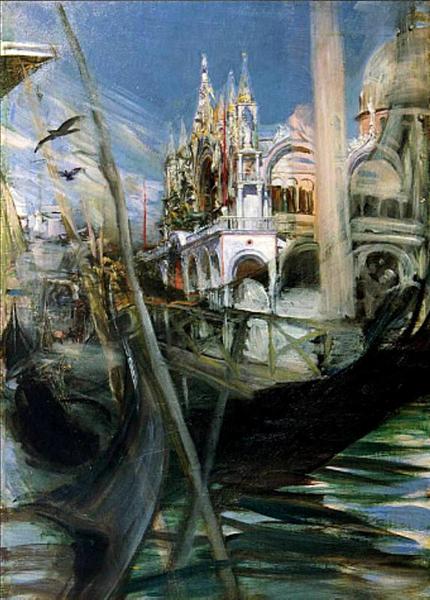Giovanni Boldini was a well-known Italian artist born in Ferrara, Italy in 1842. He lived most of his life in Paris, France, where he mostly painted commissioned portraits of “celebrities” and socialites. Once friend of Edgar Degas and John Singer Sargent, he began his career as one of the artists in a group Macchiaioli, that challenged traditional styles in painting, but soon developed his own style that could be very loosely described as being somewhere between the Impressionists and Realists. Boldini was known for using rapid, loose, flowing, sweeping or swirling brushstrokes, as well as rich colours, that gave his paintings a peculiar quality. For this technique, he was named the “Master of Swish”. Below are six of his paintings that exemplify his style.
I. Les Parisiennes [1873]; II. La Pianista [1912]


Although best known for his exquisite portraits, I like Boldini’s lesser known paintings where he portrays people engaged in their leisure or day-to-day activities, often surrounded by their sumptuous interiors. He painted ladies writing, sewing, crocheting, reading, painting and sharing a gossip, and, as a lover of music, could not resist painting ladies or men at their pianos. Les Parisiennes (The Parisians) [1873] shows two fashionable ladies, one reading Le Figaro, and another – looking eagerly out of the window. Their backdrop is a beautiful Louis XVI-decorated study with a Flemish tapestry decorating the wall. Warm-coloured La Pianista (The Lady Painist) [1912] shows a young woman in a green gown at her piano in a luxurious drawing-room. She gives the appearance of a nymph producing beautiful music under her slender fingers. The two paintings have a distinctive, whimsical feel to them. Because the faces of the people depicted, as well as the furniture, are completed in more concrete, definite brushstrokes, and the backgrounds and dresses give off a more abstract, uncertain quality, there is a sense of movement felt, as though these people are “caught in the act” of their activity, and a dreamy, almost surreal sensation emerges.
III. A Lute Player and a Listener [c. 1880]; IV. Peaceful Days [1875]


A Lute Playerand a Listener [c. 1880] shows two ladies in a richly-decorated drawing room – one playing a lute, and another – listening. Their relaxed poses, bright dresses and the mischievous smile of one of them signal their closeness and “playful” languor. Peaceful Days (or The Music Lesson) [1875] shows a lady and a boy in their drawing room. The lady is calmly sewing, while the boy sits on the floor, studying his fencing sword. The cello is seen abandoned next to them. The painting may be conveying the idleness of the moment and the boredom of the upper-classes. Although undoubtedly desiring to flatter his female clientele who commissioned the paintings, employing a style that is more “sketchy” than “fully-fledged”, Boldini’s paintings can still be said to contain much attention to detail given to certain aspects, such as to the faces of people he portrayed and to the ornamental details of furniture, carpets or dresses. He certainly tried to convey elegance, style, sophistication and grace. Also, despite the many rich colours used by Boldini, they never feel out of place, but work surprisingly harmoniously within his art.
V. The Dispatch Bearer [c. 1879]; VI. Venice [c. 1895]


The Dispatch Bearer [c. 1879] shows a member of the Parisian municipal guard delivering correspondence, probably very early in the morning. The concierge is in the act of washing the boulevard and the arrival of the guard stops his activity as he looks curiously in the direction of the guard’s bag. Realism is certainly felt in this painting, but it also has a slightly dreamy and unfocused quality to it because of the swift and uncertain brushstrokes to depict such things as the water on the boulevard. This sense of “reality meeting fiction” in Boldini’s paintings, as well as their often “sketchy” quality, means that the paintings would have also served wonderfully as illustrative materials to literature, especially to the works of such authors as Victor Hugo or Émile Zola. Giovanni Boldini’s Venice [c. 1895] is almost a nineteenth century equivalent of a “snapshot” of the city that went slightly askew. This “uncertainty” of the frame gives the painting its charm and a sense of movement, as though the painting was completed when the gondola was moving and what was “recorded” was only a slightly hazy view to the water and the magnificent architecture.


What a magnificent selection you’ve made of these Boldini paintings, not to my knowledge an artist I was aware of before but one I need to investigate further.
What I like about these is the bold (no pun intended) use of colours and the spaces surrounding the portraits. He knows how to use accent colours like red and orange and pink to draw the eye towards his subjects, to which he gives arresting postures and positions; they remind me a bit of those cut-outs, akin to kids’ stickers, which Victorians loved to glue into their scrapbooks, because they have a stand-out quality.
Then, when one has had one’s fill of the sitters, the eye is free to wander around the surrounding space to take in the details, maybe even imagining oneself within the room feeling the textures, hearing the quiet background sounds, enjoying the rich variety of furniture and decorative details. Even the two outdoor scenes borrow the techniques used for the interior paintings. Very enjoyable.
LikeLiked by 2 people
I am glad you loved the post! I feel like Boldini’s work was a little underappreciated and now deserves some more recognition, though he is best known for his portraits of beautiful women rather for the scenes I talk about in this post. You put it so well about accenting colours to emphasise the subjects in the paintings and I agree about not leaving out details of the background even if these background details are painted in a less focused style. It is also interesting that you mentioned cut-outs, because not knowing much about Victorian home-life, I almost mentioned that Boldini’s art has this “postcard”-appearance.
LikeLike
Yes, postcard appearance — I know what you mean! I couldn’t remember the name for those Victorian cut-out figures but apparently the technique is called découpage, if that’s of interest.
LikeLiked by 2 people
What stunning paintings!
LikeLiked by 2 people
The surreal-ish swishing draws our eye toward the subject, which is in clear focus. Thus, Boldini is almost simulating depth of field like a future photographer. But this technique has other effects on us as well. The subjects are also, ““caught in the act” of their activity, and a dreamy, almost surreal sensation emerges,” Well said👏🖌🎨
LikeLiked by 2 people
Yes, that is exactly how I viewed some of his work, too, as though they were “viewed” through a lens of a photographer and, like in “A Lute Player and a Listener”, Boldini is not bothered by the background, he seems to be as fascinated about it as he is about the subjects.
LikeLiked by 1 person
What a fascinating discussion! Thank you!!
LikeLiked by 1 person